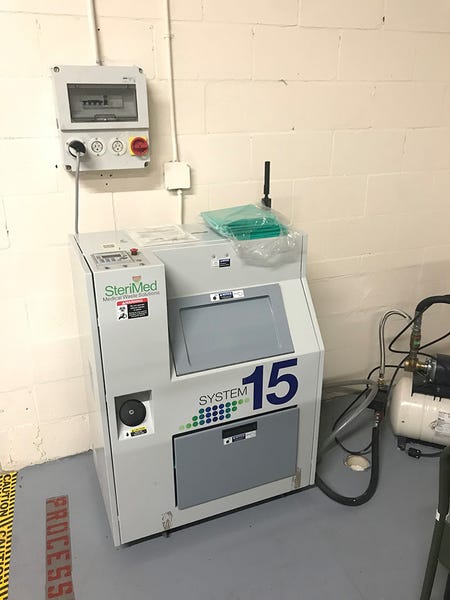The company’s fully automated system shreds, disinfects and reduces waste volume by 90 percent.

Orlando, Fla.-based medical waste disposal company Steri-Green is offering a medical waste disposal system that’s an alternative to incineration and autoclave. It’s a patented chemical sterilization process that manages almost all red-bag (potentially infectious) waste.
“It’s a more ecofriendly way to process these materials. There are no carbon emissions or heat, less energy usage and it helps reduce landfill footprint,” says Steri-Green CEO Ron Hankins.
The fully automated system shreds, disinfects and reduces waste volume by 90 percent. At a cost of $130,000, the System70 can process 1 ton a day of red-bag waste, such as sharps, clinical waste bags, dialysis filters, surgical discards and, in fact, most medical waste other than pharmaceuticals or radioactive chemotherapy. The System15, which costs $70,000, can process 500 pounds a day of the same materials.
The room-temperature process, which uses .11 kilowatt hours (kWh) of conventional electricity per cycle, results in no dioxins or furans and no bioaerosols from burning of waste.
Hankins says this patented chemical alternative costs 25 to 50 percent less than incineration or autoclave, which he attributes to the lesser energy consumption, lower landfill and transportation costs and savings resulting from generators that comply with less intensive regulations.
For each cycle, 22 gallons of water are placed in the waste receiver with the biodegradable solution that is pumped in along with up to 40 pounds of waste.

After treatment with the solution, registered with the U.S. Environmental Protection Agency, residuals may be discarded as conventional trash, in accordance with solid waste requirements. Discharged effluent is accepted by wastewater treatment plants.
Depending on waste type, a cycle duration is 16 to 19 minutes. Residual chopped material enters wastewater. While the wastewater moves on to a treatment plant, screens stop the solids, which are picked up by a conveyor belt and moved onto a waste receptacle.
A third-party lab tests each new machine to ensure bacteria, pathogens or any other potentially infectious organisms have been killed.
SteriMed Medical Waste Solutions, which owns the technology, initially trained medical waste generators to operate it at their sites. But due to issues such as high staff turnover at health facilities, the company entered a partnership to be able to offer another model. The partners launched Steri-Green, whereby Steri-Green operates the technology for waste generators.
“Now we can offer two options to end users: the service solution or they can purchase the equipment. It’s all based on the individual needs of the customer,” says Steve Hara, executive vice president of SteriMed Medical Waste Solutions.

Steri-Green picks up materials from end users on a weekly, biweekly or monthly basis. The waste is brought to its service facility for processing and landfill disposal. Loads are tracked with a bar scan and time-stamped showing when they were received and processed.
“We are happy about the relationship [with Steri-Green] and plan on growing our offerings to other cities and states,” says Hara.
Steri-Green opened its Orlando center last year to service about a 250-mile radius.
“We now have a 100-unit inventory of existing machines ready to be deployed as the business grows,” says Rada Kleyman, vice president of business development for Steri-Green.
The long-term, primary goal, says Hankins, is to figure out how to work with waste generators to separate multiple components of medical waste at their sites.

Now, Steri-Green is working with a dialysis company, starting with separating some high-grade plastics from other waste, which will go to a recycling facility.
“It’s been tested and proven that we can make waste bins, park benches, decking and other commodities that can be put to use, while these materials never hit the landfill,” says Hankins.
This alternative to incineration or autoclave is “a win-win for all,” says Kleyman. “But we have a few obstacles, such as that medical waste management is a very monopolized space and the public’s lack of awareness of the issues the old technology causes.”
“It’s made it hard to penetrate the market. We are embarking on a lengthy process of reaching out to end users and educating them on the new technology and outcome,” he adds.
About the Author(s)
You May Also Like




